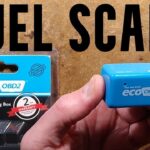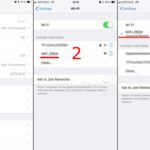Is your OBD2 port on your 2006 Ford F250 not working? This can be a frustrating issue, especially when you need to diagnose a check engine light or other vehicle problems. Fortunately, troubleshooting a non-functional OBD2 port is often straightforward and can be tackled at home with the right tools and knowledge. This guide will walk you through the common causes and diagnostic steps to get your 2006 F250’s OBD2 port back in action.
Understanding the OBD2 Port and Its Importance
The On-Board Diagnostics II (OBD2) port is a crucial interface in your 2006 Ford F250. It’s not just for check engine lights; it provides access to a wealth of data about your vehicle’s engine, transmission, ABS, and other systems. Mechanics and DIYers alike use this port with scan tools to read diagnostic trouble codes (DTCs), monitor live data, and perform various tests. Without a working OBD2 port, diagnosing even minor issues can become significantly more challenging.
Common Causes of an Inoperative OBD2 Port on a 2006 F250
Several factors can lead to a malfunctioning OBD2 port. Here are some of the most common culprits for a 2006 F250:
- Blown Fuses: This is the most frequent cause. The OBD2 port is typically powered by a fuse, and a short circuit or electrical overload can easily blow it.
- Wiring Issues: Damaged, corroded, or loose wiring leading to the OBD2 port can interrupt power and communication.
- Faulty OBD2 Port: Physical damage to the port itself, such as bent pins or internal damage, can prevent proper connection.
- Vehicle’s Computer Problems (PCM/ECM): In rare cases, a problem with the Powertrain Control Module (PCM) or Engine Control Module (ECM) can affect the OBD2 port’s functionality.
Diagnosing a Non-Working OBD2 Port
Before assuming a major issue, start with these simple diagnostic steps:
-
Check the Fuses: Locate the fuse box, usually under the dashboard or hood of your 2006 F250. Consult your owner’s manual to identify the fuse specifically for the OBD2 port or auxiliary power outlets, as they often share a fuse. Inspect the fuse for any signs of being blown (broken filament). Replace it with a fuse of the same amperage rating.
-
Visual Inspection of the OBD2 Port: Examine the OBD2 port itself. Look for any bent or damaged pins inside the connector. Ensure there’s no debris or corrosion that could be hindering a good connection.
-
Test with a Known Good OBD2 Scanner: If you have access to a different OBD2 scanner that you know is working, try using it on your F250. This helps rule out a problem with your scanner.
-
Try a Different OBD2 Device: Sometimes, a specific scan tool might have compatibility issues. Consider trying a different type of OBD2 device, such as a Bluetooth OBD2 adapter with a smartphone app.
Using a Bluetooth OBD2 Scanner and Smartphone App for Diagnosis
For a convenient and affordable diagnostic approach, consider using a Bluetooth OBD2 scanner with an Android device and apps like ForScan or Torque Pro.
ForScan is particularly recommended for Ford vehicles, including the 2006 F250, as it offers enhanced diagnostics and access to Ford-specific modules. It’s available on the Google Play Store for a small price. You’ll need a compatible Bluetooth OBD2 adapter. The BAFX Products Bluetooth OBD2 scan tool is a confirmed compatible and reliable option for many Ford owners.
Alt text: BAFX Products Bluetooth OBD2 Scanner: A reliable tool for diagnosing OBD2 port issues on 2006 Ford F250 and other vehicles. Compatible with Android devices and apps like ForScan and Torque Pro.
Torque Pro is another popular Android app that, when paired with a Bluetooth OBD2 adapter, can read generic OBD2 codes and provide real-time data. While ForScan is more Ford-focused, Torque Pro offers broader vehicle compatibility and customization options for gauges and data displays.
Steps to Use a Bluetooth OBD2 Scanner:
- Purchase a Compatible Bluetooth OBD2 Adapter: Ensure it explicitly states compatibility with OBD2 protocols (like the BAFX adapter).
- Download and Install ForScan or Torque Pro on your Android Device.
- Plug the Bluetooth OBD2 Adapter into your 2006 F250’s OBD2 Port.
- Turn your vehicle’s ignition to the “ON” position (engine off).
- Pair the Bluetooth Adapter with your Android Device via Bluetooth settings.
- Launch the ForScan or Torque Pro app and connect to the OBD2 adapter.
- Attempt to read codes or establish a connection. If the app fails to connect, it further indicates a problem with the OBD2 port or its power supply.
If you’ve checked the fuses, inspected the port, and tried different scanners without success, the issue might be with the wiring or, less likely, the PCM. At this point, consulting a qualified mechanic is recommended for further diagnosis and repair.
Conclusion
A non-working OBD2 port on your 2006 Ford F250 can be a nuisance, but often the fix is simple. By systematically checking fuses, inspecting the port, and utilizing affordable tools like Bluetooth OBD2 scanners and smartphone apps like ForScan and Torque Pro, you can effectively diagnose and potentially resolve the issue yourself. Remember to prioritize safety and consult a professional if you’re uncomfortable with any of the diagnostic steps or if the problem persists.

